
Trafikle ilgili anahtar kelimelere genel bakış. Burada henüz bilmediğiniz anahtar kelimeleri ve tanımları kolayca arayabilirsiniz.
More subjects
The coelacanths (/ˈsiːləkænθ/ SEE-lə-kanth) are fish belonging to the order Actinistia that includes two extant species in the genus Latimeria: the West Indian Ocean coelacanth (Latimeria chalumnae), primarily found near the Comoro Islands off the east coast of Africa, and the Indonesian coelacanth (Latimeria menadoensis). The name 'coelacanth' originates from the Permian genus Coelacanthus, which was the first scientifically named coelacanth. Coelacanths follow the oldest-known living lineage of Sarcopterygii (lobe-finned fish and tetrapods), which means they are more closely related to lungfish and tetrapods (which includes amphibians, reptiles, birds and mammals) than to ray-finned fish. They are found along the coastline of Indonesia and in the Indian Ocean. The West Indian Ocean coelacanth is a critically endangered species. (Source: Wikipedia.org, CC BY-SA)
The mahi-mahi (/ˈmɑːhiːˈmɑːhiː/) or common dolphinfish (Coryphaena hippurus) is a surface-dwelling ray-finned fish found in off-shore temperate, tropical, and subtropical waters worldwide. Also widely called dorado (not to be confused with Salminus brasiliensis, a fresh water fish) and dolphin, it is one of two members of the family Coryphaenidae, the other being the pompano dolphinfish. These fish are most commonly found in the waters around the Gulf of Mexico, Costa Rica, Hawaii and the Indian Ocean. (Source: Wikipedia.org, CC BY-SA)
Poecilia sphenops is a species of fish, of the genus Poecilia, known under the common name molly; to distinguish it from its congeners, it is sometimes called short-finned molly or common molly. They inhabit fresh water streams and coastal brackish and marine waters from Mexico to Colombia. The wild-type fishes are dull, silvery in color. The molly can produce fertile hybrids with many Poecilia species, most importantly the sailfin molly. The male mollies generally tend to be mildly aggressive. Mollies rank as one of the most popular feeder fish due to high growth rate, birth size, reproduction, and brood number. (Source: Wikipedia.org, CC BY-SA)
The common snook (Centropomus undecimalis) is a species of marine fish in the family Centropomidae of the order Perciformes. The common snook is also known as the sergeant fish or robalo. It was originally assigned to the sciaenid genus Sciaena; Sciaena undecimradiatus and Centropomus undecimradiatus are obsolete synonyms for the species. One of the largest snooks, C. undecimalis grows to a maximum overall length of 140 cm (4.6 ft), but the common length is 50 cm (1.6 ft). The IGFA world record is 24.32 kg (53 lb 10 oz) caught in Parismina Ranch, Costa Rica, by Rafael Montalvo. Of typical centropomid form, it possesses drab coloration except for a distinctive black lateral line. It can also have bright yellow pelvic and caudal fins, especially during spawn. (Source: Wikipedia.org, CC BY-SA)
Conger (/ˈkɒŋɡər/ KONG-gər) is a genus of marine congrid eels. It includes some of the largest types of eels, ranging up to 2 m (6 ft) or more in length, in the case of the European conger. Large congers have often been observed by divers during the day in parts of the Mediterranean Sea, and both European and American congers are sometimes caught by fishermen along the European and North American Atlantic coasts. The life histories of most conger eels are poorly known. Based on collections of their small leptocephalus larvae, the American conger eel has been found to spawn in the southwestern Sargasso Sea, close to the spawning areas of the Atlantic freshwater eels. (Source: Wikipedia.org, CC BY-SA)
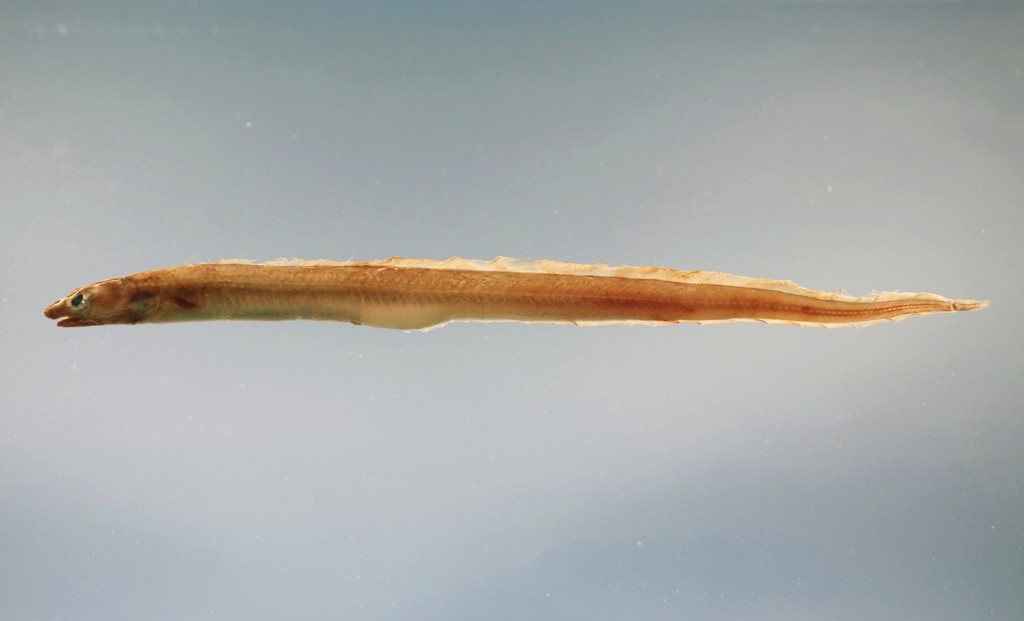 © Wikimedia.org/NOAA, CC0
© Wikimedia.org/NOAA, CC0
The cookiecutter shark (Isistius brasiliensis), also called the cigar shark, is a species of small squaliform shark in the family Dalatiidae. This shark occurs in warm, oceanic waters worldwide, particularly near islands, and has been recorded as deep as 3.7 km (2.3 mi). It migrates vertically up to 3 km (1.9 mi) every day, approaching the surface at dusk and descending with the dawn. Reaching only 42–56 cm (16.5–22 in) in length, the cookiecutter shark has a long, cylindrical body with a short, blunt snout, large eyes, two tiny spineless dorsal fins, and a large caudal fin. It is dark brown, with light-emitting photophores covering its underside except for a dark 'collar' around its throat and gill slits. (Source: Wikipedia.org, CC BY-SA)
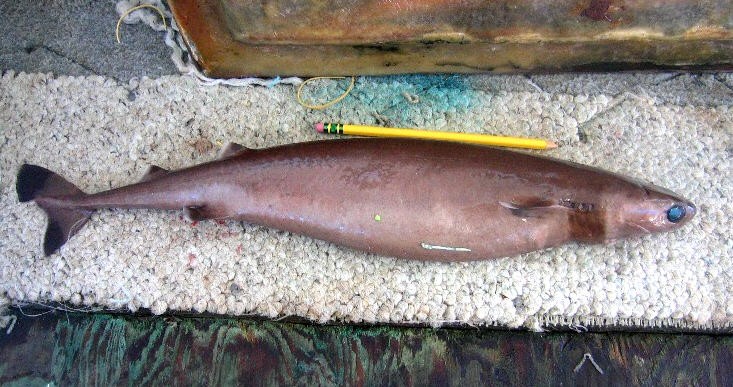 © Wikimedia.org/NOAA, CC0
© Wikimedia.org/NOAA, CC0
Crappies (/ˈkrɒpi, ˈkræpi/) are two species of North American freshwater fish of the genus Pomoxis in the family Centrarchidae (sunfishes). Both species of crappies are popular game fish among recreational anglers. The Pomoxis species are highly regarded panfish and are often considered to be among the best-tasting freshwater food fish. Because of their diverse diets, crappie may be caught in many ways, including casting light jigs, trolling with minnows or soft lures, using small spinnerbaits, or using bobbers with common hookbaits. Crappies are also popular with ice anglers, as they are active in winter. (Source: Wikipedia.org, CC BY-SA)
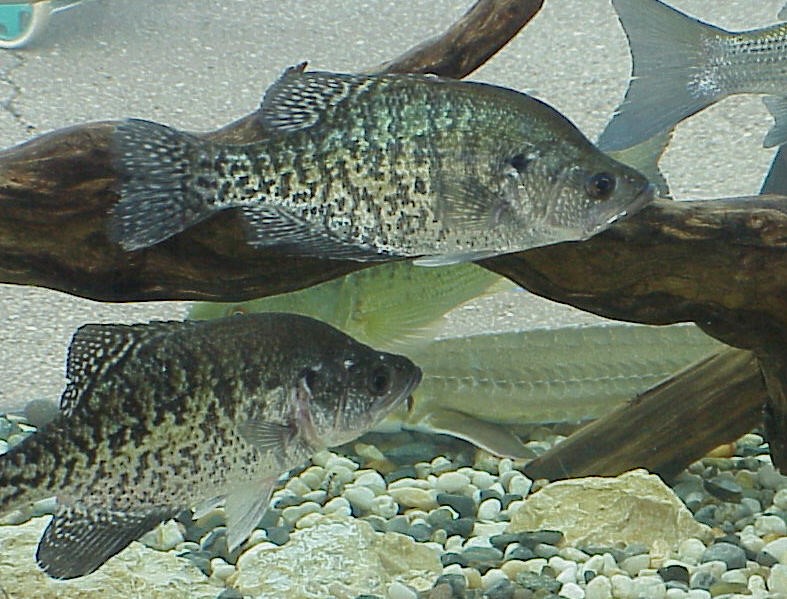 © Wikimedia.org/U.S. Army Corps of Engineers, CC0
© Wikimedia.org/U.S. Army Corps of Engineers, CC0
Danio is a genus of small freshwater fish in the family Cyprinidae found in South and Southeast Asia, commonly kept in aquaria. They are generally characterised by a pattern of horizontal stripes, rows of spots or vertical bars. Some species have two pairs of long barbels. Species of this genus consume various small aquatic insects, crustaceans and worms. (Source: Wikipedia.org, CC BY-SA)
Symphysodon, colloquially known as discus, is a genus of cichlids native to the Amazon river basin in South America. Due to their distinctive shape, behavior, and bright colors and patterns, discus are popular as freshwater aquarium fish, and their aquaculture in several countries in Asia is a major industry. They are sometimes referred to as pompadour fish. The discus fish has attracted a cult following of collectors and has created a multimillion dollar international industry complete with shows, competitions, and reputed online breeders[citation needed]. (Source: Wikipedia.org, CC BY-SA)
 © Wikimedia.org/Patrick Farrelly, CC0
© Wikimedia.org/Patrick Farrelly, CC0
Stomiidae is a family of deep-sea ray-finned fish, including the barbeled dragonfishes. They are quite small, usually around 15 cm, up to 26 cm. These fish are apex predators and have enormous jaws filled with fang-like teeth. They are also able to hinge the neurocranium and upper-jaw system, which leads to the opening of the jaw to more than 100 degrees. This ability allows them to consume extremely large prey, often 50% greater than their standard length. (Source: Wikipedia.org, CC BY-SA)
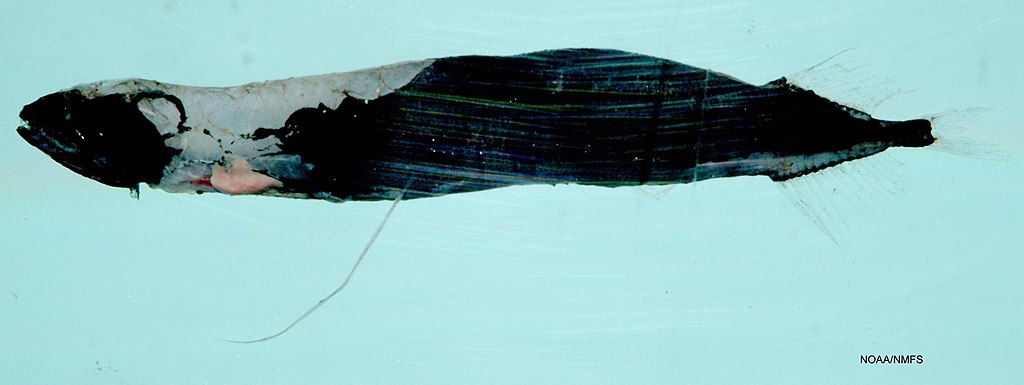 © Wikimedia.org/NOAA, CC BY
© Wikimedia.org/NOAA, CC BY
Sciaenidae are a family of fish in the order Acanthuriformes. They are commonly called drums or croakers in reference to the repetitive throbbing or drumming sounds they make. The family consists of about 286 to 298 species in about 66 to 70 genera. A sciaenid has a long dorsal fin reaching nearly to the tail, and a notch between the rays and spines of the dorsal, although the two parts are actually separate. Drums are somberly coloured, usually in shades of brown, with a lateral line on each side that extends to the tip of the caudal fin. The anal fin usually has two spines, while the dorsal fins are deeply notched or separate. Most species have a rounded or pointed caudal fin. The mouth is set low and is usually inferior. Their croaking mechanism involves the beating of abdominal muscles against the swim bladder. (Source: Wikipedia.org, CC BY-SA)
Eels are ray-finned fish belonging to the order Anguilliformes (/æŋˈɡwɪlɪfɔːrmiːz/), which consists of eight suborders, 19 families, 111 genera, and about 800 species. Eels undergo considerable development from the early larval stage to the eventual adult stage, and are usually predators. The term 'eel' is also used for some other eel-shaped fish, such as electric eels (genus Electrophorus), spiny eels (family Mastacembelidae), swamp eels (family Synbranchidae), and deep-sea spiny eels (family Notacanthidae). These other clades, however, evolved their eel-like shapes independently from the true eels. Eels live both in salt water and fresh water and some species are catadromous. (Source: Wikipedia.org, CC BY-SA)
 © Wikimedia.org/Ellen Edmonson and Hugh Chrisp, CC0
© Wikimedia.org/Ellen Edmonson and Hugh Chrisp, CC0
Electric catfish or Malapteruridae is a family of catfishes (order Siluriformes). This family includes two genera, Malapterurus and Paradoxoglanis, with 21 species. Several species of this family have the ability to generate electricity, delivering a shock of up to 350 volts from its electric organ. Electric catfish are found in tropical Africa and the Nile River. Electric catfish are usually nocturnal and carnivorous. Some species feed primarily on other fish, incapacitating their prey with electric discharges, but others are generalist bottom foragers, feeding on things like invertebrates, fish eggs, and detritus. The largest can grow to about 1.2 meters (3 ft) long, but most species are far smaller. (Source: Wikipedia.org, CC BY-SA)
The electric eels are a genus, Electrophorus, of neotropical freshwater fish from South America in the family Gymnotidae. They are known for their ability to stun their prey by generating electricity, delivering shocks at up to 860 volts. Their electrical capabilities were first studied in 1775, contributing to the invention in 1800 of the electric battery. Despite their name, electric eels are not closely related to the true eels (Anguilliformes) but are members of the electroreceptive knifefish order, Gymnotiformes. This order is more closely related to catfish. In 2019, electric eels were split into three species: for more than two centuries before that, the genus was believed to be monotypic, containing only Electrophorus electricus. (Source: Wikipedia.org, CC BY-SA)
The escolar, Lepidocybium flavobrunneum, a species of fish in the family Gempylidae, is found in deep (200–885 metres, or 656–2,904 ft) tropical and temperate waters around the world. It is also known as snake mackerel, walu walu (Hawaiian, sometimes written waloo), and is sometimes sold as 'butterfish' or 'white tuna', a matter aggravated by potential health problems related to consumption of escolar, giving rise to the mocking name Ex-Lax fish. (Source: Wikipedia.org, CC BY-SA)
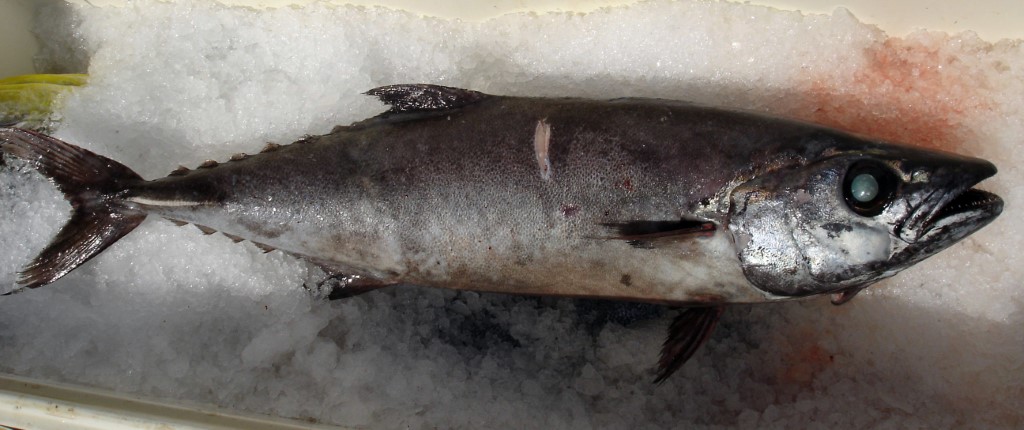 © Wikimedia.org/Allen Shimada, CC0
© Wikimedia.org/Allen Shimada, CC0
Fangtooths are beryciform fish of the family Anoplogastridae (sometimes spelled 'Anoplogasteridae') that live in the deep sea. The name is from the Greek anoplo, meaning 'unarmed', and γαστήρ (gastḗr), meaning 'stomach'. With a circumglobal distribution in tropical and cold-temperate waters, the family contains only two very similar species in one genus, with no known close relatives. (Source: Wikipedia.org, CC BY-SA)
The fire eel (Mastacembelus erythrotaenia) is a relatively large species of spiny eel. This omnivorous freshwater fish is native to in Southeast Asia but also found in the aquarium trade. Although it has declined locally (especially in Thailand) because of this trade and overfishing for food, it remains common overall. The fire eel is not a true eel, but an extremely elongated fish with a distinctive pointed snout and underslung mouth. It is part of a group of fishes called spiny eels that also includes tire track and peacock eels. The group gets its common name from the many small dorsal spines that precede the dorsal fin. (Source: Wikipedia.org, CC BY-SA)
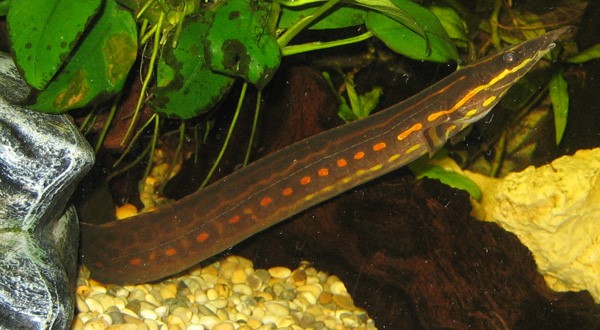 © Wikimedia.org/Llandor, CC BY-SA
© Wikimedia.org/Llandor, CC BY-SA
The Florida gar (Lepisosteus platyrhincus) is a species of gar found in the US from the Savannah River and Ochlockonee River watersheds of Georgia and throughout peninsular Florida. Florida gar can reach a length over 3 ft (91 cm). The young feed on zooplankton and insect larvae, as well as small fish. Adults mainly eat fish, shrimp, and crayfish. Although edible, they are not popular as food. The roe is highly toxic to many animals, including humans and birds. (Source: Wikipedia.org, CC BY-SA)
Flounders are a group of flatfish species. They are demersal fish, found at the bottom of oceans around the world; some species will also enter estuaries. Larval flounder are born with one eye on each side of their head, but as they grow from the larval to juvenile stage through metamorphosis, one eye migrates to the other side of the body. As a result, both eyes are then on the side which faces up. The side to which the eyes migrate is dependent on the species type. As an adult, a flounder changes its habits and camouflages itself by lying on the bottom of the ocean floor as protection against predators. (Source: Wikipedia.org, CC BY-SA)
Flowerhorn cichlids are ornamental aquarium fish noted for their vivid colors and the distinctively shaped heads for which they are named. Their head protuberance is formally called a nuchal hump. Like blood parrot cichlids, they are hybrids that exist in the wild only because of their release. Flowerhorns first emerged for sale on the aquarium market in Malaysia in the late 1990s and soon became popular in many countries in Asia. They are commonly kept by hobbyists in the US, Asia, and Europe. Numerous cast-off flowerhorns have been released to the wild, especially in Singapore and Malaysia, where they have become an invasive pest animal. Their importation is banned in Australia. (Source: Wikipedia.org, CC BY-SA)
The footballfish form a family, Himantolophidae, of globose, deep-sea anglerfishes found in tropical and subtropical waters of the Atlantic, Indian, and Pacific Ocean. The family contains about 22 species all in a single genus, Himantolophus (from the Greek imantos, 'thong, strap', and lophos, 'crest'). As in most other deep-sea anglerfish families, sexual dimorphism is extreme: the largest females may exceed lengths of 60 centimetres (24 inches) and are globose in shape, whereas males do not exceed 4 cm (1+1⁄2 in) as adults and are comparatively fusiform. Their flesh is gelatinous, but thickens in the larger females, which also possess a covering of 'bucklers' — round, bony plates each with a median spine — that are absent in males. Both are a reddish brown to black in life. (Source: Wikipedia.org, CC BY-SA)
The frilled shark (Chlamydoselachus anguineus) and the southern African frilled shark (Chlamydoselachus africana) are the two extant species of shark in the family Chlamydoselachidae. The frilled shark is considered a living fossil, because of its primitive, anguilliform (eel-like) physical traits, such as a dark-brown color, amphistyly (the articulation of the jaws to the cranium), and a 2.0 m (6.6 ft)–long body, which has dorsal, pelvic, and anal fins located towards the tail. The common name, frilled shark, derives from the fringed appearance of the six pairs of gill slits at the shark's throat. (Source: Wikipedia.org, CC BY-SA)
Frogfishes are any member of the anglerfish family Antennariidae, of the order Lophiiformes. Antennariids are known as anglerfish in Australia, where the term 'frogfish' refers to members of the unrelated family Batrachoididae. Frogfishes are found in almost all tropical and subtropical oceans and seas around the world, the primary exception being the Mediterranean Sea. Frogfishes are small, short and stocky, and sometimes covered in spinules and other appendages to aid in camouflage. The camouflage aids in protection from predators and enables them to lure prey. Many species can change colour; some are covered with other organisms such as algae or hydrozoa. In keeping with this camouflage, frogfishes typically move slowly, lying in wait for prey, and then striking extremely rapidly, in as little as 6 milliseconds. (Source: Wikipedia.org, CC BY-SA)
The Galapagos shark (Carcharhinus galapagensis) is a species of requiem shark, in the family Carcharhinidae, found worldwide. It favors clear reef environments around oceanic islands, where it is often the most abundant shark species. A large species that often reaches 3.0 m (9.8 ft), the Galapagos reef shark has a typical fusiform 'reef shark' shape and is very difficult to distinguish from the dusky shark (C. obscurus) and the grey reef shark (C. amblyrhynchos). An identifying character of this species is its tall first dorsal fin, which has a slightly rounded tip and originates over the rear tips of the pectoral fins. The Galapagos shark is an active predator often encountered in large groups. It feeds mainly on bottom-dwelling bony fishes and cephalopods; larger individuals have a much more varied diet, consuming other sharks, marine iguanas, sea lions, and even garbage. As in other requiem sharks, reproduction is viviparous, with females bearing litters of 4–16 pups every 2 to 3 years. The juveniles tend to remain in shallow water to avoid predation by the adults. (Source: Wikipedia.org, CC BY-SA)
Gars are members of the family Lepisosteidae, which are the only surviving members of the Ginglymodi, an ancient holosteian group of ray-finned fish, which first appeared during the Triassic, over 240 million years ago. Gars comprise seven living species of fish in two genera that inhabit fresh, brackish, and occasionally marine waters of eastern North America, Central America and Cuba in the Caribbean, though extinct members of the family were more widespread. Gars have elongated bodies that are heavily armored with ganoid scales, and fronted by similarly elongated jaws filled with long, sharp teeth. Gars are sometimes referred to as 'garpike', but are not closely related to pike, which are in the fish family Esocidae. All of the gars are relatively large fish, but the alligator gar (Atractosteus spatula) is the largest; the alligator gar often grows to a length over 2 m (6.5 ft) and a weight over 45 kg (100 lb), and specimens of up to 3 m (9.8 ft) in length have been reported. Unusually, their vascularised swim bladders can function as lungs, and most gars surface periodically to take a gulp of air. Gar flesh is edible and the hard skin and scales of gars are used by humans, but gar eggs are highly toxic. (Source: Wikipedia.org, CC BY-SA)
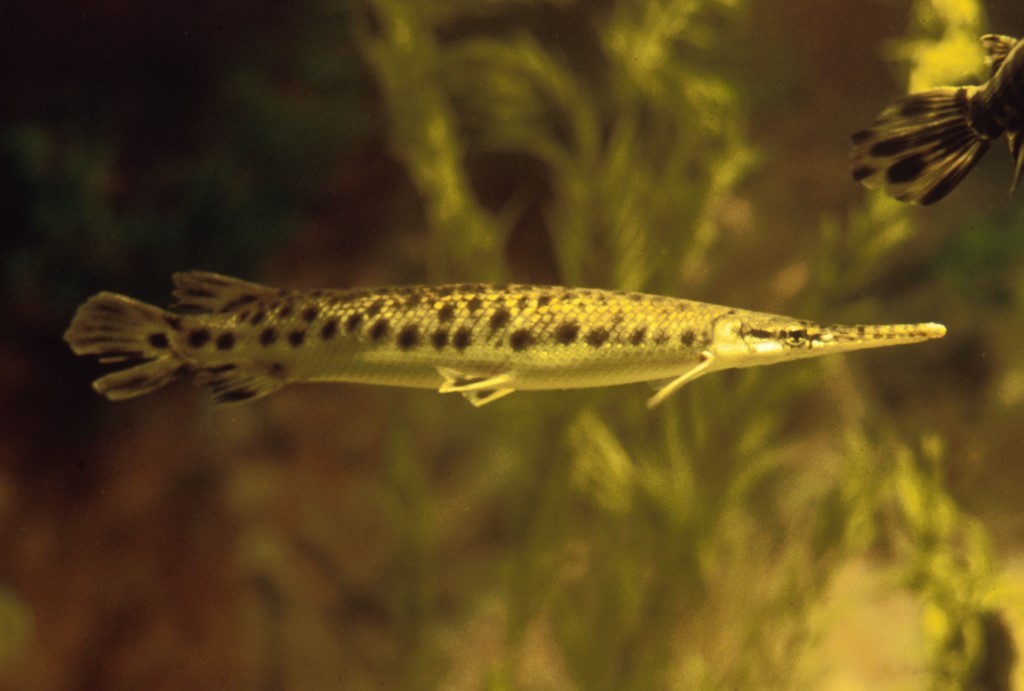 © Wikimedia.org/U.S. Fish and Wildlife Service, CC0
© Wikimedia.org/U.S. Fish and Wildlife Service, CC0
The garden eels are the subfamily Heterochongrinae in the conger eel family Congridae. The majority of garden eels live in the Indo-Pacific, but species are also found in warmer parts of the Atlantic Ocean (including the Caribbean) and East Pacific. These small eels live in burrows on the sea floor and get their name from their practice of poking their heads from their burrows while most of their bodies remain hidden. Since they tend to live in groups, the many eel heads 'growing' from the sea floor resemble the plants in a garden. They vary greatly in colour depending on the exact species involved. The largest species reaches about 120 cm (47 in) in length, but most species do not surpass 60 cm (24 in). Garden eel colonies can grow as large as one acre in surface area. (Source: Wikipedia.org, CC BY-SA)
Kryptopterus vitreolus, known in the aquarium trade traditionally as the glass catfish and also as the ghost catfish or phantom catfish, is a small species of Asian glass catfish. It is commonly seen in the freshwater aquarium trade, but its taxonomy is confusing and was only fully resolved in 2013. It is endemic to Thailand, and found in rivers south of the Isthmus of Kra that drain into the Gulf of Thailand and river basins in the Cardamom Mountains. There are also unconfirmed reports from Penang in Malaysia. (Source: Wikipedia.org, CC BY-SA)
 © Wikimedia.org/The Great Mule of Eupatoria, CC BY-SA
© Wikimedia.org/The Great Mule of Eupatoria, CC BY-SA
The goblin shark (Mitsukurina owstoni) is a rare species of deep-sea shark. Sometimes called a 'living fossil', it is the only extant representative of the family Mitsukurinidae, a lineage some 125 million years old. This pink-skinned animal has a distinctive profile with an elongated, flat snout, and highly protrusible jaws containing prominent nail-like teeth. It is usually between 3 and 4 m (10 and 13 ft) long when mature, though it can grow considerably larger such as one captured in 2000 that is thought to have measured 6 m (20 ft). Goblin sharks are benthopelagic creatures that inhabit upper continental slopes, submarine canyons, and seamounts throughout the world at depths greater than 100 m (330 ft), with adults found deeper than juveniles. Some researchers believe that these sharks could also dive to depths of up to 1,300 m (4,270 ft), for short periods of time. (Source: Wikipedia.org, CC BY-SA)
The goldfish (Carassius auratus) is a freshwater fish in the family Cyprinidae of order Cypriniformes. It is commonly kept as a pet in indoor aquariums, and is one of the most popular aquarium fish. Goldfish released into the wild have become an invasive pest in parts of North America. Native to East Asia, the goldfish is a relatively small member of the carp family (which also includes the Prussian carp and the crucian carp). It was first selectively bred for color in imperial China more than 1,000 years ago, and several distinct breeds have since been developed. Goldfish breeds vary greatly in size, body shape, fin configuration, and coloration (various combinations of white, yellow, orange, red, brown, and black are known). (Source: Wikipedia.org, CC BY-SA)
 © Wikimedia.org/Souravgg8, CC BY-SA
© Wikimedia.org/Souravgg8, CC BY-SA
Hydrocynus goliath, also known as the goliath tigerfish, giant tigerfish, or mbenga, is a very large African predatory freshwater fish of the family Alestidae. This large-toothed, highly predatory fish grows to an average length of 1.5 m (4.9 ft) and a weight of 50 kg (110 lb). Its teeth fit into distinct grooves along its jaws. On average each of its teeth can grow up to 2.5 cm (1 in), according to biologist and television presenter Jeremy Wade. The largest recorded specimen weighed 70 kg (154 lb). (Source: Wikipedia.org, CC BY-SA)
Bagarius yarrelli, also known as the giant devil catfish or goonch, is a very large species of catfish in the genus Bagarius found in rivers in the Indian subcontinent. The species reaches up to 2 m (6.6 ft) in length. It may be synonymous with B. bagarius. It is found in large rivers in the South Asia, including rivers with fast current, particularly in deeper pools near faster current, but never in small streams. It is found in the Indus and Ganges basins as well as most of southern India east of the Western Ghats. (Source: Wikipedia.org, CC BY-SA)
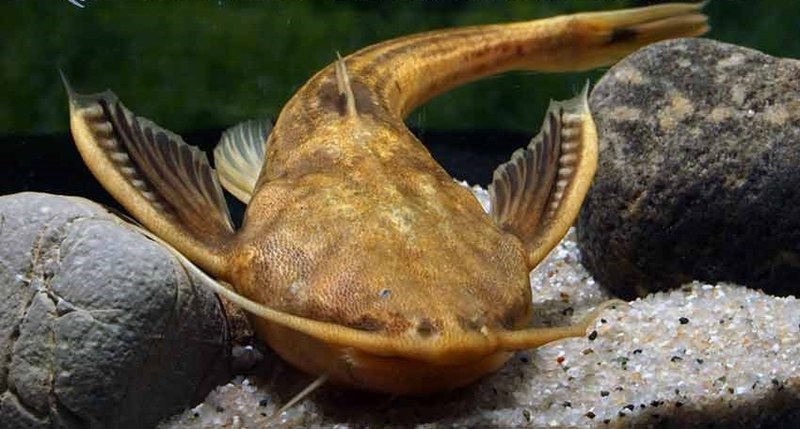 © Wikimedia.org/M0N73R0, CC BY-SA
© Wikimedia.org/M0N73R0, CC BY-SA
The grass carp (Ctenopharyngodon idella) is a species of large herbivorous freshwater fish in the family Cyprinidae, native to the Pacific Far East, with a native range stretching from northern Vietnam to the Amur River on the Sino-Russian border. This Asian carp is the only species of the genus Ctenopharyngodon. Grass carp are resident fish of large turbid rivers and associated floodplain lakes/wetlands with a wide range of temperature tolerance, and spawn at temperatures of 20 to 30 °C (68 to 86 °F). It is cultivated as a food fish in China for centuries, but was introduced in Europe and the United States for aquatic weed control, becoming the fish species with the largest reported farmed production globally, over five million tonnes per year. (Source: Wikipedia.org, CC BY-SA)
The great hammerhead (Sphyrna mokarran) or great hammerhead shark is the largest species of hammerhead shark, belonging to the family Sphyrnidae, attaining an average length of 4.6 m (15 ft) and reaching a maximum length of 6.1 m (20 ft). It is found in tropical and warm temperate waters worldwide, inhabiting coastal areas and the continental shelf. The great hammerhead can be distinguished from other hammerheads by the shape of its 'hammer' (called the 'cephalofoil'), which is wide with an almost straight front margin, and by its tall, sickle-shaped first dorsal fin. A solitary, strong-swimming apex predator, the great hammerhead feeds on a wide variety of prey ranging from crustaceans and cephalopods, to bony fish, to smaller sharks. Observations of this species in the wild suggest that the cephalofoil functions to immobilize stingrays, a favored prey. This species has a viviparous mode of reproduction, bearing litters of up to 50 pups every two years. (Source: Wikipedia.org, CC BY-SA)
The great white shark (Carcharodon carcharias), also known as the white shark, white pointer, or simply great white, is a species of large mackerel shark which can be found in the coastal surface waters of all the major oceans. It is notable for its size, with larger female individuals growing to 6.1 m (20 ft) in length and 1,905–2,268 kg (4,200–5,000 lb) in weight at maturity. However, most are smaller; males measure 3.4 to 4.0 m (11 to 13 ft), and females measure 4.6 to 4.9 m (15 to 16 ft) on average. According to a 2014 study, the lifespan of great white sharks is estimated to be as long as 70 years or more, well above previous estimates, making it one of the longest lived cartilaginous fishes currently known. According to the same study, male great white sharks take 26 years to reach sexual maturity, while the females take 33 years to be ready to produce offspring. Great white sharks can swim at speeds of 25 km/h (16 mph) for short bursts and to depths of 1,200 m (3,900 ft). (Source: Wikipedia.org, CC BY-SA)
The Greenland shark (Somniosus microcephalus), also known as the gurry shark, grey shark, or by the Kalaallisut name eqalussuaq, is a large shark of the family Somniosidae ('sleeper sharks'), closely related to the Pacific and southern sleeper sharks. The distribution of this species is mostly restricted to the waters of the North Atlantic Ocean and Arctic Ocean; however, more recent evidence indicates that at great depths it may range as far south as the Caribbean. The Greenland shark has the longest known lifespan of all vertebrate species (estimated to be between 250 and 500 years), and is among the largest extant species of shark. It is a generalist feeder, consuming a variety of available foods. As an adaptation to living at depth, it has a high concentration of trimethylamine N-oxide in its tissues, which causes the meat to be toxic. Greenland shark flesh, treated to reduce toxin levels, is eaten in Iceland as a delicacy known as kæstur hákarl. As it lives in the cold depths of the Arctic and North Atlantic, isolated from human activity, it is not known to be a threat to humans, and no attacks have been recorded. (Source: Wikipedia.org, CC BY-SA)
 © Wikimedia.org/NOAA, CC0
© Wikimedia.org/NOAA, CC0
The gray reef shark (Carcharhinus amblyrhynchos, sometimes misspelled amblyrhynchus or amblyrhinchos) is a species of requiem shark, in the family Carcharhinidae. One of the most common reef sharks in the Indo-Pacific, it is found as far east as Easter Island and as far west as South Africa. This species is most often seen in shallow water near the drop-offs of coral reefs. It has the typical 'reef shark' shape, with a broad, round snout and large eyes. It can be distinguished from similar species by the plain or white-tipped first dorsal fin, the dark tips on the other fins, the broad, black rear margin on the tail fin, and the lack of a ridge between the dorsal fins. Most individuals are less than 1.88 m (6.2 ft) long. (Source: Wikipedia.org, CC BY-SA)
The guppy (Poecilia reticulata), also known as millionfish and rainbow fish, is one of the world's most widely distributed tropical fish and one of the most popular freshwater aquarium fish species. It is a member of the family Poeciliidae and, like almost all American members of the family, is live-bearing. Guppies originate from northeast South America, but have been introduced to many environments and are now found all over the world. They are highly adaptable and thrive in many different environmental and ecological conditions. Male guppies, which are smaller than females, have ornamental caudal and dorsal fins. Wild guppies generally feed on a variety of food sources, including benthic algae and aquatic insect larvae. Guppies are used as a model organism in the fields of ecology, evolution, and behavioural studies. (Source: Wikipedia.org, CC BY-SA)
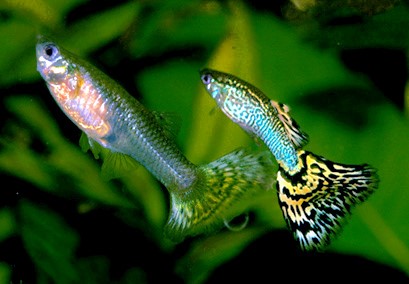 © Wikimedia.org/Marrabbio2, CC BY-SA
© Wikimedia.org/Marrabbio2, CC BY-SA
The haddock (Melanogrammus aeglefinus) is a saltwater ray-finned fish from the family Gadidae, the true cods. It is the only species in the monotypic genus Melanogrammus. It is found in the North Atlantic Ocean and associated seas where it is an important species for fisheries, especially in northern Europe where it is marketed fresh, frozen and smoked; smoked varieties include the Finnan haddie and the Arbroath smokie. The haddock has the elongated, tapering body shape typical of members of the cod family. It has a relatively small mouth which does not extend to below the eye; with the lower profile of the face being straight and the upper profile slightly rounded, this gives its snout a characteristic wedge-shaped profile. The upper jaw projects beyond the lower more so than in the Atlantic cod. There is a rather small barbel on the chin. There are three dorsal fins, the first being triangular in shape and these dorsal fins have 14 to 17 fin rays in the first, 20 to 24 in the second, and 19 to 22 in the third. There are also two anal fins and in these there are 21 to 25 fin rays in the first and 20 to 24 fin rays in the second. The anal and dorsal fins are all separated from each other. The pelvic fins are small with an elongated first fin ray. (Source: Wikipedia.org, CC BY-SA)
Hagfish, of the class Myxini /mɪkˈsaɪnaɪ/ (also known as Hyperotreti) and order Myxiniformes /mɪkˈsɪnɪfɔːrmiːz/, are eel-shaped, slime-producing marine fish (occasionally called slime eels). They are the only known living animals that have a skull but no vertebral column, although hagfish do have rudimentary vertebrae. Along with lampreys, hagfish are jawless; the two form the sister group to jawed vertebrates, and living hagfish remain similar to hagfish from around 300 million years ago. The classification of hagfish had been controversial. The issue was whether the hagfish was a degenerate type of vertebrate-fish that through evolution had lost its vertebrae (the original scheme) and was most closely related to lampreys, or whether hagfish represent a stage that precedes the evolution of the vertebral column (the alternative scheme) as is the case with lancelets. Recent DNA evidence has supported the original scheme. (Source: Wikipedia.org, CC BY-SA)
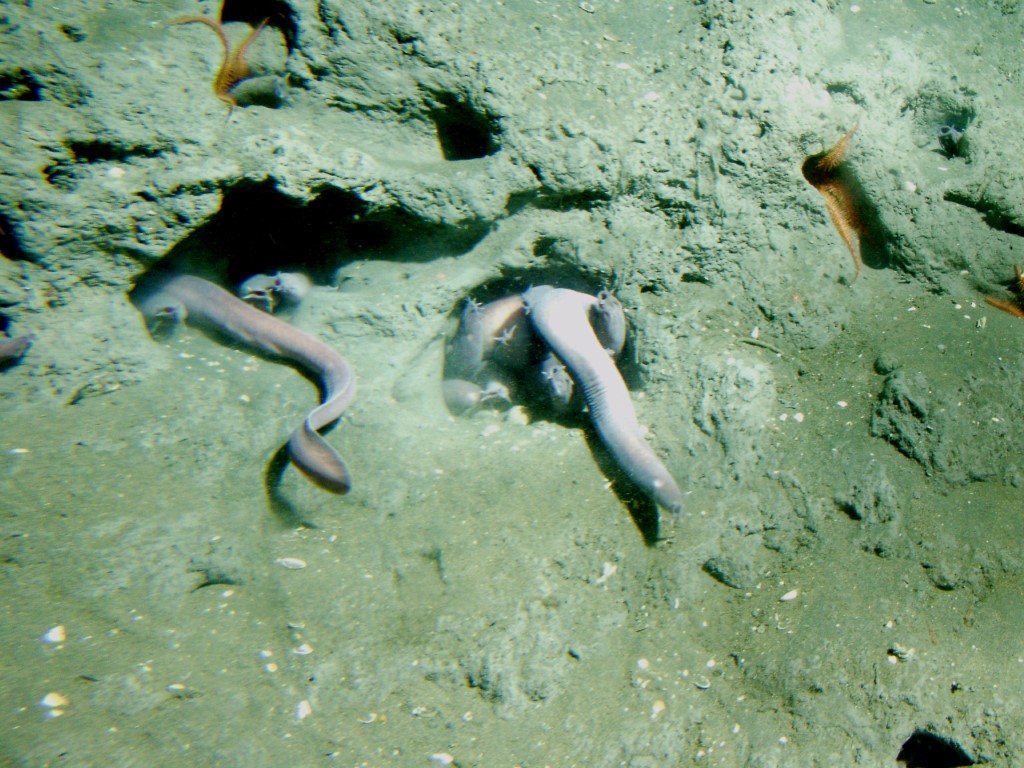 © Wikimedia.org/NOAA, CC0
© Wikimedia.org/NOAA, CC0
Halibut is the common name for three flatfish in the genera Hippoglossus and Reinhardtius from the family of right-eye flounders and, in some regions, and less commonly, other species of large flatfish. The word is derived from haly (holy) and butte (flat fish), for its popularity on Catholic holy days. Halibut are demersal fish and are highly regarded as a food fish as well as a sport fish. Halibut feed on almost any fish or animal they can fit into their mouths. Juvenile halibut feed on small crustaceans and other bottom-dwelling organisms. Animals found in their stomachs include sand lance, octopus, crab, salmon, hermit crabs, lamprey, sculpin, cod, pollock, herring, and flounder, as well as other halibut. Halibut live at depths ranging from a few meters to hundreds of meters, and although they spend most of their time near the bottom, halibut may move up in the water column to feed. (Source: Wikipedia.org, CC BY-SA)

Time for recess! Post a comment, ask a question or write a review. Feel free to let us know what you think!
Ben fransada turkce deralere girecem ehliyet ici sinavlari bilen bana yardimci olur mu
Mrhaba bu hafta yaziliya girecem bana yardimci olmak isteyen varmi isvec yazilisina cok korkuyorum yalniz
Orda tabela var otoban başlangıçı icin sorular bunlar Otoyolun başlangıçı Park etmek yasaktır Otobanın başlangıcı Giriş yapmak yasaktır Ben otobanın başlangıçı basıyom yok yanlışmiş otoyolun başlangıçıymız tabi biz türkiyede yaşıyoz unutum ben amk
Elinize sağlık Türkiye'de olmayan birçok levha var.Mantık yürüterek dogru cevapları bulmaya çalıştım.
Gercekten emeginize saglık. Alakasız ve yanlıs birsürü testle karşılaştım, sonunda faydalı bir sayfaya denk geldim.
Merhaba benim Türk ehliyetim var Romanya ehliyeti ile değiştirmek istiyorum nasıl yapabilirim
Dun sinava girdim tek bir soruyla kaybettim dogru bildim konturol ettim 3 soruyu yannis ciklarla cevirdim
HAZIRLAYANLARDAN ALLAH RAZI OLSUN IN$LLH COK GÜZEL-TEK SIKINTI COK AZ TÜRKCE CEVIRIMLERDE AMA OLSUN BEN COK BEGENDIM TE$EKKÜRLER
Bazı sorularda yazımı da aynı olan 2 aynı doğru cevap var. Örnek: Yayalar için yolun sonu. Yerleşim alanının sonu. Bir yerleşim alanının başlangıcı. Yerleşim alanının sonu.